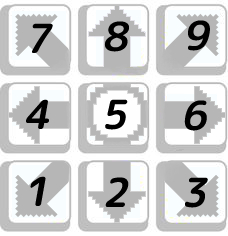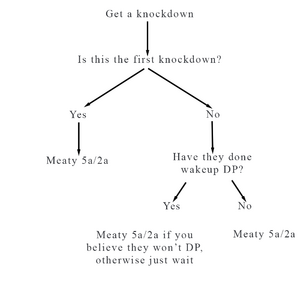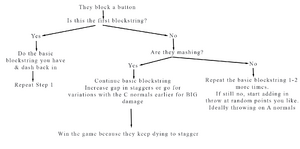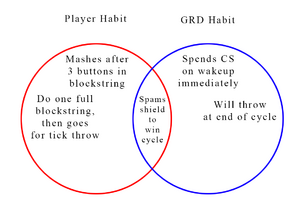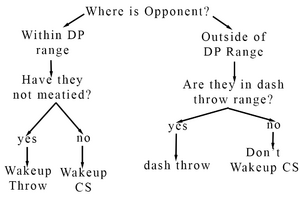User:SaltyGoku/Under Night 101
Under Night 101
By: Salty
Multiple terms used in here can be found in the FG Glossary here, please reference it if you are ever confused! This document also uses numpad notation, feel free to refer to this image if you are not used to using it
Introduction to Under Night:
Q. Who do I play?
A. Play whoever you think is cool and/or fun. Tiers in under night do not matter, wald got third and easily could’ve won at Combo Breaker. Anyone who really makes a fuss about tiers or character strength is cringe, you can @ me(@SaltyGoku in discord) if you see this happening and I’ll get on their ass in real time.
Q. Where can I find good information on my character?
A. The under night in birth discord has a series of character channels made just for this, and a wiki of each character is generally in the pins. Please check the pins of the associated character channels to see common information they might have stored. There is also a vod storage that can be found here
Q. What is the bar on the bottom of the screen?
A. The bottom bar is GRD, and after the middle circle completes 1 revolution, the player with the most grd blocks wins the cycle and gains access to a series of features. GRD is an important mechanic that allows for unique situations that can only be found in under night. We will go more in depth on this later. For now, just know that in general gaining GRD is good and losing grd is cringe.
Q. I don’t know what to do first to get better
A. If you’re a beginner or a newer player, you have the freedom to pick anything to get better at, and you’ll drastically improve. There is no “correct” way to start your own personal improvement. I recommend fully reading this doc and then choosing something you want to improve at first or copy from another top player.
How to run offense:
Under-night at the end of the day is a fighting game, and follows a majority of the principles that are found in normal fighting games. Offense in under night can be run very straight forward, especially as a rushdown character. This Section will cover offense at a general level, however some characters(ex: hilda, vat, yuzu) might not use everything found in here. Video by Mo.Sin I recommend to check out on pressure
Basic Blockstring: After you have found a character that you enjoy, spend some time getting down a simple combo and an idea of a basic blockstring. My general suggestion for one is one that follows an A normal meaty that uses a majority of staggerable options which could lead to throw. This blockstring should end safely and in a way you can dash back in to "loop" this blockstring if the opponent doesn't contest the dash.
If you’re unsure what type of blockstrings to go for, refer to the vod review database I previously linked and look for one you really like that someone does!
Basic Blockstring Variations: Your blockstring should have a few variations so someone isn't too comfortable, even if its swapping around two buttons for another it could have huge implications. Mess around with them and figure out what feels best, and implement them as a “mixup” to your normal blockstrings.
Once you get a hit in neutral, follow the associated flowchart to find what to do.
In short: Generally you will always want to go for a meaty option, however there are exceptions to this that will be explained in the GRD section of the doc.
Throw Usage: At any point in the blockstring following knockdown, you should be able to THROW your opponent to keep them guessing, however this should only be done if they are NOT mashing. If you are consistently getting a combo from your pressure, feel free to continue what you’re doing! Example Here
How are Opponents always teching my throws: In undernight, there’s a concept known as an OS, or an option select. They are very common, but we won’t dive deep into them as you’re just starting out. However, they are important to know about. In short, an OS will allow them to tech your throw and cover other options at the same time. Refer to this sheet for different OS options & what to do to beat them. Generally, I recommend waiting first and seeing what they do to identify it, or just staggering and going from there!
Blockstring Flowchart: After you have gotten your meaty, here is a general flow for how you can expect your offense to go with your basic blockstring you’ve made/stolen.
You should mainly only go for throws if your opponent seems to not care for mashing. When you go for these throws, think less of it in relation to cycle, and more to making them want to throw. You can throw loop, tick throw, whatever, as long as they start to mash more it’s good.
Rebeats: An important factor that many high level players use in undernight are rebeats. In under night, you are able to press any button in any order.You can go from A to B to C, or C to A to B, or anything similar!
Rebeats generally are done when you want to do a C normal, and “rebeat”(reverse beat) into a whiffing A normal. A normals have the shortest amount of frames generally, allowing for you to be the least amount minus, about -1 to -3 give or take on the character, however characters like hyde and mika have some rebeats that can be plus, so watch out for those.
Generally rebeats are used to restart pressure easily without dashing in again, and can catch mashes if someone isn't fast enough. Example Here
Rebeats do have a flaw, as they are nearly always negative. Because of this, if you consistently rebeat in a certain spot you will get punished and possibly get hit. Be careful when you go for rebeats! They have many uses that we’ll be covering later on.
Shield: Shield is an important factor in your offense that you have to consider, as it does change frame data on your moves, and can function as a minor pushblock(however its not strong as one). Shield is a committal option that takes two forms, blue shield and green shield. Blue shield can only be done in a neutral state, and green shield in blockstun. For either of them, if you throw them they will be grd broken.
Differences in Blue & Green Shield: Blue shield is more committal as they can’t change they guard like green shield! Blue shield only spends meter, but green shield(if nothing connects to it) will make them waste meter AND grd. Blue shield also gives the opponent a bit more plus frames, however green shield gives you a lot more plus frames if it doesnt turn into blue shield in time.
How to beat shields: A few easy ways to play around shield is to rebeat when you believe a shield is coming to grd break them via throw, or if they’re green shielding, letting it “whiff” so you can redash back in and make them lose grd & meter. Examples here on how I punish different shields Mess around and figure out ways you can punish various shields!
How to make your opponent feel dumb:
Even with all the crazy mechanics in under night, if you can out read your opponent, you will always win. When it comes to recognizing habits, it is a lot simpler than most will tell you, you just need to know what you’re looking for.
Habit breakdown: Habits can be broken down into two categories. Player habits, and GRD habits. Player habits are habits that would exist without the existence of GRD as a mechanic, GRD habits are habits that exist only in the context of GRD in the game.
Habits exist no matter the level, even the best players in the world are prone to bad habits. The difference is being able to identify them.
What to look for when identifying habits: When you play, think of why they are doing something. Are they doing a lot of staggers? They must be fishing for a counter hit, that means you can play for cycle safely. Are they shielding your pressure often? End it early with a rebeat and go for a grd break! Below is a venn diagram to show some ideas of habits in under night that are commonly found.
Once you identify a players general habits, you are able to start outplaying them at a much easier pace. Its important to learn this skill early, as everything you do will be built on it.
Reasoning Behind Every Button: Thinking about habits allows you to give more purpose to your moves. Every button that you press should have a “reason” behind it, even a bad reason done with confidence has a better chance to win than a good reason done with doubt. If you fully believe in the read, full send it! You can only get better from here anyway, so there’s no risk in trying out new things.
Stay conscious of what your opponent is doing, and once you start to outplay them, they’ll feel like everything they do is “wrong”. Once this feeling is established, the game is pretty much guaranteed in your favor.
Blocking doesn’t equal losing:
Unlike in many fighting games, blocking isn’t equal to losing in undernight. Its generally preferred depending on the scenario! This section is going to go over what you’re expected to do on defense, and what to look for to get rid of those “how do I escape this” type feelings.
Blocking = More GRD: For starters, blocking gives you access to passive grd gain! As long as you don’t have vorpal, you’ll gain it for blocking attacks, and gain extra for blocking any high attacks. This can allow you to take advantage of more habits from your enemy if you’re winning cycle, or allow you to wait & spend CS.
How to escape opponents pressure: Every blockstring has a point where they will always be opened up, these are situations like rebeats or “redashes”. A redash is when someone ends their pressure string and dashes back in to restart it. At this point, they are giving you an opening to freely hit them and get your turn back. Do NOT react to the dash, instead use the habits that youve gained from the set so far and mash when you fully believe they will redash back in or rebeat.
How do I beat throw?: At your current level, beating throw with an OS is out of the question. Not because they’re difficult or complex, but because you need to build good habits. Focus less on “teching” the throw, and more on the “when” of the throw. Are they throwing at a certain point in cycle? Or is it after a series of buttons? Defense is where the skills you’ve built for habit recognition really shine through, and allow for insane comebacks and shutdown potential.
They keep doing assault without any button, what do I do??: This is referred to as an “empty assault” and is common if you are showing shield vs it, as they get the ability to grd break you by going low. What you want to do is hit 4A at the timing where they’re just about to land, this way you are blocking if they really do an assault button, or catch them landing and get a combo! This is known as “fuzzy mashing”, and can greatly decrease the strain you put on yourself vs assaults. Here is an example of me showing it off.
I’m constantly wrong when I mash, how am I supposed to mash “correctly”?: When you choose to mash, it should be with 100% confidence, and ideally within the buffer window. If you are mashing on a reaction timing, your opponent will win 9/10. If you are still losing while mashing like this, stop mashing for a bit and just watch your opponent to get a read on their habits. Remember, look for the redash/throws/rebeats and hit them THERE. Until then, just block and shield.
Ok but how do I use shield?: Ideally you want to use green shield only in guaranteed interactions, moves that will always have multiple hits. If you can, try to blue shield projectiles as theyre easier to react to & allow for a lot of grd gain for little risk. From here, identify when your opponent isn’t punishing certain shields or is going for consistent buttons and just take those as free shields!
GRD rules the world(kinda):
GRD is the main mechanic in under night, and is consistent across everything that you do. No matter what, you will always be fighting for GRD one way or another, even on accident. Video by Mo.Sin on GRD situations I recommend
How I want you to see GRD: GRD until a high/top level is mostly going to be a “snapshot” of the GRD timer, and who outplayed who better. Some actions will affect cycle more, like getting a hit, throwing someone, or shielding a button, so its important to keep in mind if someone is leaning towards having a stronger grd play or not. This is a skill you will get over time, and I don’t expect to be picked up easily. I don’t want you to actually PLAY for cycle, instead I want you to focus on punishing them playing for cycle if it comes down to it, as your skills towards habit recognition should carry in this instance.
How do I use CS?: So you’ve won cycle and have access to vorpal, and in extension CS, the strongest mechanic in the game. CS allows you to freeze time for ⅔ of a second, and can get you a free punish if someone is doing something. The most common point to spend this is on wakeup, but it can be a confusing situation if you don’t know the flow of this situation. Below is the flowchart you should follow if you have vorpal on your own wakeup. Assume your opponent will be following the same flowchart if they have vorpal on wakeup.
Threatening the Threat of CS: CS is one of the strongest tools in the game, and allows you to quickly turn a situation around. So much so that people have to change how they structure pressure to not die to CS. Because of this, you don’t have to spend it the moment you have it. Holding on to it can allow you to take your turn back if someone keeps baiting out your CS. Keep in mind, the threat of the option is just as strong as doing it!
How GRD and shield are related: Shield is one of the main ways you will be trying to win cycle or prevent cycle wins. As mentioned earlier, rebeats can be a great help in this. This is because on the whiff of a green shield, you will cause them to lose a substantial amount of GRD. Continuous use of this can add up quickly, and all but guarantee you winning cycle.
End of Lesson:
Under night is a fighting game at its core with multiple mechanics giving it a very intense depth to it, however you must first build a solid foundation before you’re really able to play the grd mindgame at a high level. In my personal opinion, you don’t need to be good at playing grd until you are looking to become a high level player, as you can win a majority of cycles off of outplaying your opponents player habits. These main points in this doc, as well as the flowcharts in them, are pieces of how I see undernight dialed down to a level that is simple enough to easily replicate. If there are any questions, reach out to me on discord at SaltyGoku, or on twitter @Supergokudude. I’m always available to help out player looking to improve at under night, and if this doc has any issues youve noticed or something isnt explained well enough, let me know and I’ll do what I can to fix it. Thank you very much.
